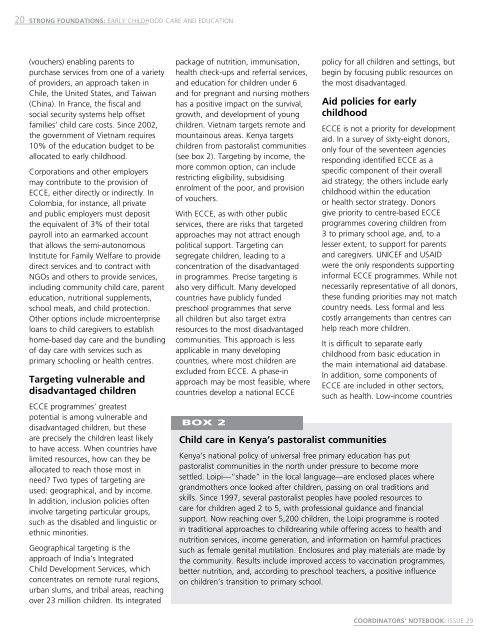A global call to action for early childhood
A global call to action for early childhood
A global call to action for early childhood
You also want an ePaper? Increase the reach of your titles
YUMPU automatically turns print PDFs into web optimized ePapers that Google loves.
20 Strong foundations: Early <strong>childhood</strong> care and education<br />
(vouchers) enabling parents <strong>to</strong><br />
purchase services from one of a variety<br />
of providers, an approach taken in<br />
Chile, the United States, and Taiwan<br />
(China). In France, the fiscal and<br />
social security systems help offset<br />
families’ child care costs. Since 2002,<br />
the government of Vietnam requires<br />
10% of the education budget <strong>to</strong> be<br />
allocated <strong>to</strong> <strong>early</strong> <strong>childhood</strong>.<br />
Corporations and other employers<br />
may contribute <strong>to</strong> the provision of<br />
ECCE, either directly or indirectly. In<br />
Colombia, <strong>for</strong> instance, all private<br />
and public employers must deposit<br />
the equivalent of 3% of their <strong>to</strong>tal<br />
payroll in<strong>to</strong> an earmarked account<br />
that allows the semi-au<strong>to</strong>nomous<br />
Institute <strong>for</strong> Family Welfare <strong>to</strong> provide<br />
direct services and <strong>to</strong> contract with<br />
NGOs and others <strong>to</strong> provide services,<br />
including community child care, parent<br />
education, nutritional supplements,<br />
school meals, and child protection.<br />
Other options include microenterprise<br />
loans <strong>to</strong> child caregivers <strong>to</strong> establish<br />
home-based day care and the bundling<br />
of day care with services such as<br />
primary schooling or health centres.<br />
Targeting vulnerable and<br />
disadvantaged children<br />
ECCE programmes’ greatest<br />
potential is among vulnerable and<br />
disadvantaged children, but these<br />
are precisely the children least likely<br />
<strong>to</strong> have access. When countries have<br />
limited resources, how can they be<br />
allocated <strong>to</strong> reach those most in<br />
need? Two types of targeting are<br />
used: geographical, and by income.<br />
In addition, inclusion policies often<br />
involve targeting particular groups,<br />
such as the disabled and linguistic or<br />
ethnic minorities.<br />
Geographical targeting is the<br />
approach of India’s Integrated<br />
Child Development Services, which<br />
concentrates on remote rural regions,<br />
urban slums, and tribal areas, reaching<br />
over 23 million children. Its integrated<br />
package of nutrition, immunisation,<br />
health check-ups and referral services,<br />
and education <strong>for</strong> children under 6<br />
and <strong>for</strong> pregnant and nursing mothers<br />
has a positive impact on the survival,<br />
growth, and development of young<br />
children. Vietnam targets remote and<br />
mountainous areas. Kenya targets<br />
children from pas<strong>to</strong>ralist communities<br />
(see box 2). Targeting by income, the<br />
more common option, can include<br />
restricting eligibility, subsidising<br />
enrolment of the poor, and provision<br />
of vouchers.<br />
With ECCE, as with other public<br />
services, there are risks that targeted<br />
approaches may not attract enough<br />
political support. Targeting can<br />
segregate children, leading <strong>to</strong> a<br />
concentration of the disadvantaged<br />
in programmes. Precise targeting is<br />
also very difficult. Many developed<br />
countries have publicly funded<br />
preschool programmes that serve<br />
all children but also target extra<br />
resources <strong>to</strong> the most disadvantaged<br />
communities. This approach is less<br />
applicable in many developing<br />
countries, where most children are<br />
excluded from ECCE. A phase-in<br />
approach may be most feasible, where<br />
countries develop a national ECCE<br />
BOX 2<br />
policy <strong>for</strong> all children and settings, but<br />
begin by focusing public resources on<br />
the most disadvantaged.<br />
Aid policies <strong>for</strong> <strong>early</strong><br />
<strong>childhood</strong><br />
Child care in Kenya’s pas<strong>to</strong>ralist communities<br />
ECCE is not a priority <strong>for</strong> development<br />
aid. In a survey of sixty-eight donors,<br />
only four of the seventeen agencies<br />
responding identified ECCE as a<br />
specific component of their overall<br />
aid strategy; the others include <strong>early</strong><br />
<strong>childhood</strong> within the education<br />
or health sec<strong>to</strong>r strategy. Donors<br />
give priority <strong>to</strong> centre-based ECCE<br />
programmes covering children from<br />
3 <strong>to</strong> primary school age, and, <strong>to</strong> a<br />
lesser extent, <strong>to</strong> support <strong>for</strong> parents<br />
and caregivers. UNICEF and USAID<br />
were the only respondents supporting<br />
in<strong>for</strong>mal ECCE programmes. While not<br />
necessarily representative of all donors,<br />
these funding priorities may not match<br />
country needs. Less <strong>for</strong>mal and less<br />
costly arrangements than centres can<br />
help reach more children.<br />
It is difficult <strong>to</strong> separate <strong>early</strong><br />
<strong>childhood</strong> from basic education in<br />
the main international aid database.<br />
In addition, some components of<br />
ECCE are included in other sec<strong>to</strong>rs,<br />
such as health. Low-income countries<br />
Kenya’s national policy of universal free primary education has put<br />
pas<strong>to</strong>ralist communities in the north under pressure <strong>to</strong> become more<br />
settled. Loipi—“shade” in the local language—are enclosed places where<br />
grandmothers once looked after children, passing on oral traditions and<br />
skills. Since 1997, several pas<strong>to</strong>ralist peoples have pooled resources <strong>to</strong><br />
care <strong>for</strong> children aged 2 <strong>to</strong> 5, with professional guidance and financial<br />
support. Now reaching over 5,200 children, the Loipi programme is rooted<br />
in traditional approaches <strong>to</strong> childrearing while offering access <strong>to</strong> health and<br />
nutrition services, income generation, and in<strong>for</strong>mation on harmful practices<br />
such as female genital mutilation. Enclosures and play materials are made by<br />
the community. Results include improved access <strong>to</strong> vaccination programmes,<br />
better nutrition, and, according <strong>to</strong> preschool teachers, a positive influence<br />
on children’s transition <strong>to</strong> primary school.<br />
COORDINATORS’ NOTEBOOK: ISSUE 29
















